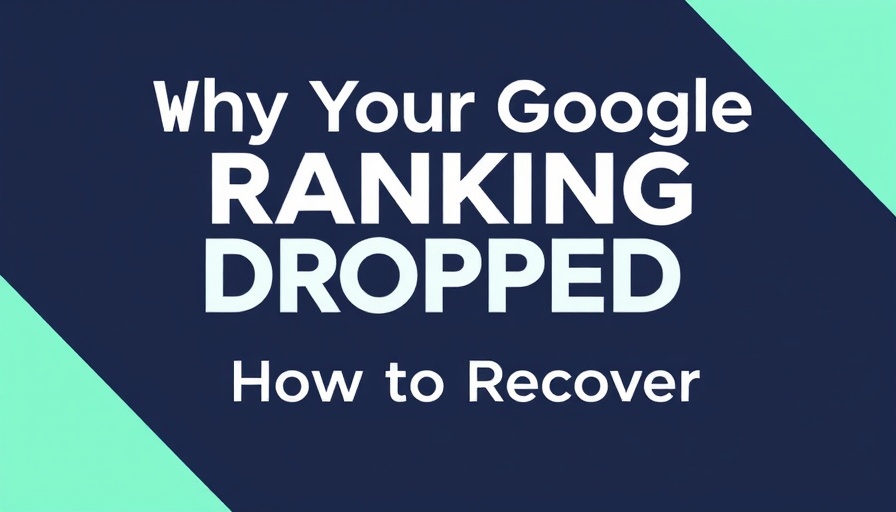
Understanding Google Rankings: Why They Dropped and How to Regain Positioning
The digital landscape is constantly changing, particularly in the realm of search engine optimization (SEO). Recent shifts in Google’s algorithms have left many small business owners, marketers, and agencies grappling with sudden declines in their website traffic and visibility. Understanding why these rankings dropped is essential to honing responsive strategies for recovery. In this article, we will delve into the reasons behind ranking fluctuations and provide actionable steps to restore and enhance your SEO presence.
The Impact of Google Algorithm Updates
Google's algorithm is the foundation on which its search engine operates, filled with intricate rules that determine how pages rank on search engine results pages (SERPs). Frequent updates can result in dramatic shifts in how content is valued and prioritized. For instance, Google executed approximately 4,725 changes in 2022 alone, translating to around 13 updates per day. This consistent evolution in Google's systems can directly affect a site’s performance, leading to concerning traffic drops for many businesses.
Identifying the Causes of Ranking Drops
To effectively address a decline in rankings, the initial step is to pinpoint the causes. Algorithm changes often target specific attributes such as content quality, relevance, and user experience. Updates like the March 2024 Core Update aimed to eliminate unhelpful content significantly, prompting website owners to revisit their content strategy. Fluctuations may arise from:
- Declining Content Quality: Low-quality or outdated content can adversely impact rankings.
- User Experience Issues: Factors like slow loading times, mobile unfriendliness, or confusing navigation deter users.
- Competitive Landscape: Competitors may enhance their content or SEO tactics, outpacing your site's visibility.
Steps to Recover and Improve Your Rankings
After identifying root causes, it’s essential to implement a structured recovery strategy. The following nine steps have shown significant results in helping sites bounce back:
- Confirm Algorithm Updates: Use tools like Google Search Console to track changes associated with recent algorithm updates.
- Analyze Traffic Data: Consulting Google Analytics allows you to assess how traffic patterns shifted before and after an update.
- Keyword Performance Evaluation: Identify and prioritize keywords that experienced drops, adjusting your content strategy accordingly.
- Conduct a Technical SEO Audit: Check for crawl errors, broken links, and site architecture issues that may hinder performance.
- Quality Content Review: Regularly audit content to ensure it aligns with Google's E-E-A-T guidelines emphasizing experience, expertise, authoritativeness, and trustworthiness.
- Competitive Analysis: Study competitors’ strategies to identify strengths and weaknesses in your content versus theirs.
- Link Profile Assessment: Review your backlink portfolio using tools to identify lost valuable links.
- Enhance Content: Update and improve existing content based on insights gained from previous steps.
- Monitor Changes: Continuously track your metrics to observe the impacts of changes over time.
Future Outlook: Importance of User Experience
With Google increasingly prioritizing user experience, optimizing your site for performance is integral. Elements such as loading speed, mobile-friendliness, and engaging content are vital. Websites designed with users in mind often outperform others across various metrics, leading to enhanced SEO results. Businesses can improve their connections to users by genuinely addressing their needs and interests.
Implementing AI in Your SEO Strategy
Emerging tools and technologies, particularly AI, can revolutionize SEO practices. By investing in AI-driven analytics, businesses can glean deeper insights on user behavior, enhancing the personalization of content delivery. For example, utilizing AI-powered SEO tools can help streamline keyword research, optimize content relating to user queries and enhance website performance.
Call to Action
As a small business owner or marketer, understanding the ever-evolving landscape of SEO is crucial for driving traffic and generating leads. Implement these strategies to monitor changes in your rankings and user behaviors consistently, adapting your approach as needed. With the right focus and tools, you can not only recover from dips in rankings but also gain a competitive edge in the digital marketplace.
 Add Row
Add Row  Add
Add 




Write A Comment